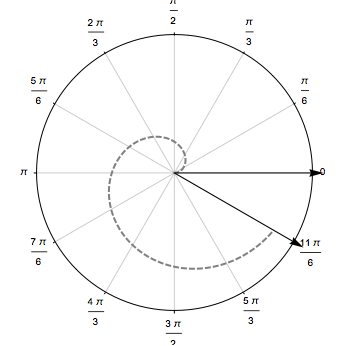On the one hand, velocity \(v\) of the dust speck should satisfy
\begin{equation*}
v = \frac{\Delta s}{\Delta t} \, \text{inches per minute},
\end{equation*}
where \(\Delta s\) (in inches) is the distance travelled along the outer edge of the record for a corresponding change in time \(\Delta t\) (in minutes). On the other hand, \(\Delta s = r \cdot \Delta\theta\) is just arclength, so that:
\begin{equation*}
v =\frac{\Delta s}{\Delta t}=\frac{r \cdot \Delta \theta}{\Delta t}= r \times \frac{\Delta \theta}{\Delta t}
\end{equation*}
The quantity \(\frac{\Delta \theta}{\Delta t}\) (in radians per minute) is called the angular velocity and in this case, is \(33\) rpm. Of course, we must convert this to radians
\begin{equation*}
v = 5 \, {\rm inches} \times \frac{33 \, \rm revolutions}{\rm minute} \times \frac{2 \pi}{1 \, \rm revolution} \approx 1036.5 \frac{\rm inches}{\rm minute}
\end{equation*}
Observe how the radian measure of \(2\pi\) contributes no units to answer. If the record plays for 4 minutes and 10 seconds, it will travel
\begin{equation*}
s = 1036.5 \frac{\rm inches}{\rm minute} \times \left(4+\frac{10}{60}\right)\,{\rm minutes} \approx 4318 \,{\rm inches}
\end{equation*}






